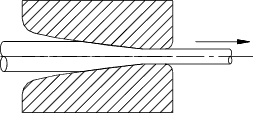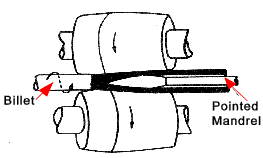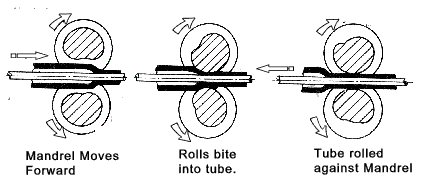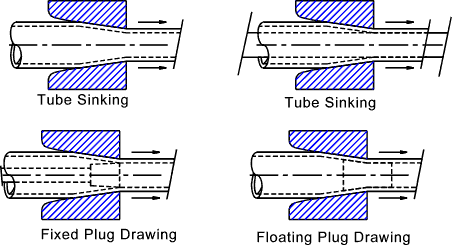|
|
|
Primary Processes Wire & Tube Drawing Process
Wire Drawing The process of wire drawing involves the production of wire of close diameter and tolerance by drawing
descaled hot-rolled rod through a die. The finished wire is coiled onto a motor driven block.
The dies are manufactured from hard material e.g tungsten carbide. Diamonds dies are used for small diameter
wire. Soap is used for lubrication. If large diameter reductions are required the rod
is progressively drawn through several stages of dies and blocks.
Steel Tube Manufacture Most ferrous seamless tubes are first rotary forged. This process consists of two hot working processes the first of which is rotary piercing.
In rotary piercing a rolling mill consisting of two rolls set at an angle to each other is used- see the figure
above. A metal billet is fed into the rolls which simultaneously rotate and draw the billet forward.
Because of the small diameter of the rolls the outside of the billet is deformed resulting in a tensile
stress at its centre. A cavity is induced in the centre of the billet,the formation of which is assisted and
controlled by a profiled mandrel. The type of rolling mill shown in the figure
is the Mannesmann mill. The second stage in producing seamless steel tubes is to locate the rough tube onto a mandrel and roll it to reduce its wall thickness. A Pilger mill is one which can be used for this process. The roll arrangement and process are shown in the figure below.
A heated tube is reciprocated under cam shaped rolls. First the tube is moved forward under the rolls. The profiles of the rolls are shaped so that on rotation they bite into the tube to force it down onto the mandrel. The mandrel is then moved back to drag the tube against the rolls and smooth its outside diameter. The cycle is repeated. Tube drawing If cold drawn seamless tubing is require with small diameters, thin walls, or a smooth
surface finish then the tubes manufacturing process is completed using cold drawing.
The simplest option sinking is the least accurate. Using a plug or/and a mandrel
results in more accurate tubes but more energy is required for the process.. The processes above relate mainly to ferrous materials. Copper and Alumininium tubing is more often produced by direct extrusion. |
Links Providing relevant information
|
|
Manufacturing Index
Primary Processes



